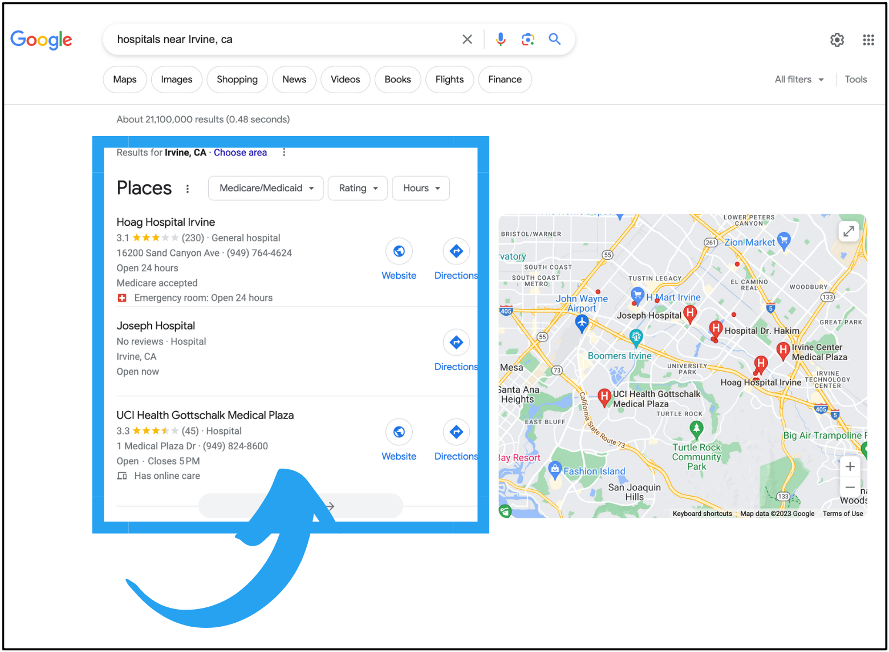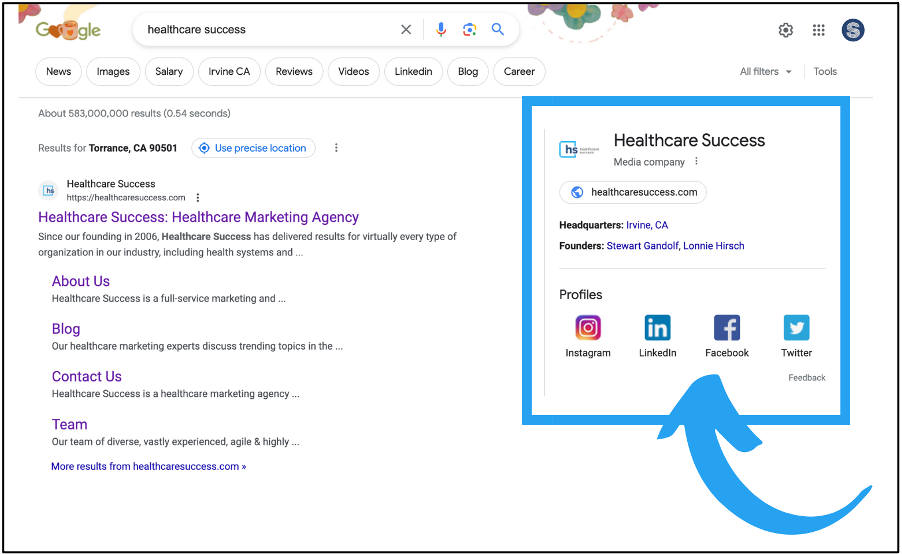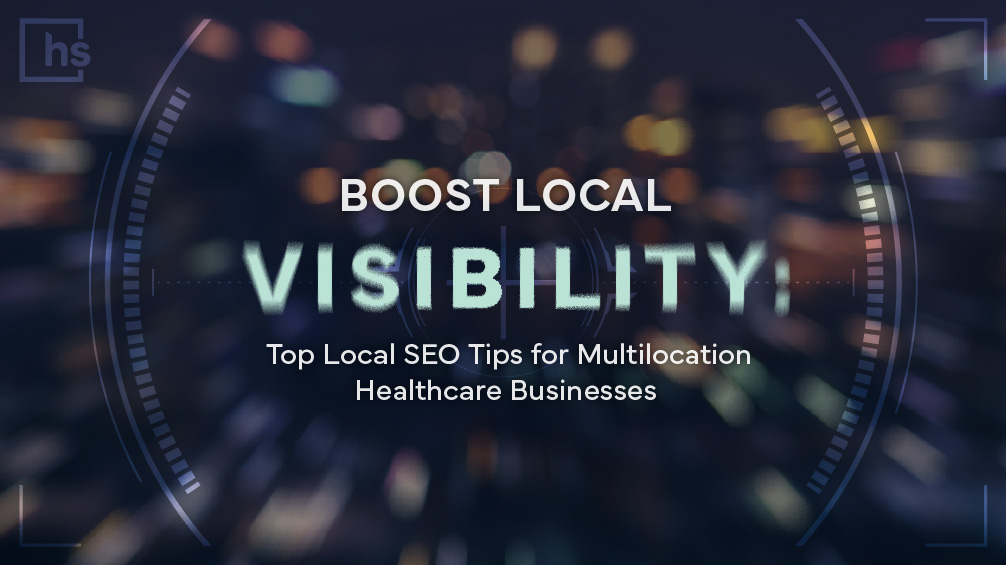Boost Local Visibility: Top Local SEO Tips for Multilocation Healthcare Businesses
Consumers across the globe have come to rely on search engines for reliable, trustworthy, accurate, and timely healthcare information. This has significantly increased competition among providers, making SEO—particularly local SEO—a crucial part of any digital marketing strategy.
Local SEO is beneficial for any size business but critical for multilocation companies. By implementing local seo for multiple locations, healthcare businesses can boost their visibility in search results, attract more qualified leads, drive more patient acquisitions, and grow their revenue.
In this post, I share the three essential steps to maximize local SEO for multilocation healthcare businesses.
But first…
What Is Local SEO for Multiple Locations?
Local SEO for multiple locations is the process of optimizing your website, microsites, or landing pages for local search. Local SEO tactics help local consumers find your business more easily, increasing your chance of ranking in Google's Local Pack.
The process involves implementing strategies and tactics that cater to each location individually while maintaining consistent branding and messaging.
3 Steps to Boost Visibility for Multiple Healthcare Locations With Local SEO
Here are three local SEO steps you can use to boost the visibility of each of your locations.
Let’s begin with key on-page SEO tactics, then cover off-page SEO.
Step 1: Build Fully Optimized Web Pages
Here’s how to do it
Begin with competitor research
Before you begin a local seo strategy for multiple locations, understanding what your competitors are doing is essential. Conducting a competitor analysis allows you to examine their local SEO strategies and uncover opportunities to strengthen your local SEO and page rank.
Develop unique, quality location pages
Your corporate website must include one optimized web page for each provider location. These pages help
- Reach local audiences more effectively
- Boost impressions
- Improve your local page rank for local, long-tailed keyword terms (e.g., “well woman care in Los Angeles”)
- Increase your chances of appearing in the Google Local Pack—the most sought-after position on Google’s local search results page.
Location-specific pages should include
- NAPW details (e.g., company name, address, phone number, and website)
- Images of the waiting room, reception, exam rooms, team members, etc.
- Product or service offerings
- Business hours
- Patient comments, reviews, and testimonials
- Embedded Google map
- Directions of where and how to get to your business (be sure to include popular local landmarks, if possible, so Google can easily connect as entities)
- News and events
Optimize each location page with location-specific keywords
When creating location-specific landing pages, including your target area (e.g., city, town, or province) is essential for local SEO for medical professionals.
Here are a few places that must have location-specific content:
- Title tags
This HTML tag tells Google and other search engines what the page title is and plays a crucial role in organic ranking. - Meta description tags
This HTML tag gives Google and other search engines a summary of the page and plays a crucial role in organic ranking. - Schema markup for local optimization or rich snippets
Schema and rich snippets are types of structured data you can add to the backend of your site to classify the page content. This content appears in Google's search results as extra information to the typical blue title tag and meta description. - H1 with Local Keyword Targets
The H1 tag is the first or primary page headline. When creating a location-specific web page, include your target local area. - Optimized body copy for local keywords
On-page optimization is crucial for local SEO. When creating a local web page, it’s important to create content that is highly optimized for the local area you’re targeting. For example, if you’re targeting “well woman care in Los Angeles,” you must ensure page content is appropriately optimized for this keyword phrase.
It is equally important to include the address of your business location directly on this page in text form.
- Write unique local content per page
In addition to creating optimized body copy, it's essential that each location page on your website has unique local content tailored to the specific products and services they offer and want to grow. For example, if you have three locations providing similar services, it's crucial to differentiate them to avoid duplicate content, which can hurt your local page rank.
Build backlinks to your location pages
Backlinks support higher page rankings because search engines view the quality and quantity of these links as votes of confidence from other websites.
Building a backlink strategy for each of your location pages is crucial for ranking higher for local search terms. Here are a few ways you can do it
- Create valuable content
The first step in any effective backlink strategy is to give consumers educational, helpful, and valuable content.
Consider posting keyword-rich blogs, news, or other timely, educational content to each microsite to attract interest (and links), then leverage other marketing channels (e.g., email, social, and paid ads) to share your content.
- Become a sponsor
You can also sponsor local events or participate in local charities to build awareness and acquire backlinks from colleges, event websites, or local news outlets.
- Host events or other meetups
Consider hosting open houses, grand openings, flu vaccine clinics, or other informal meetups to generate buzz around your local businesses and build links in the process.
Develop a strong local SEO linking strategy
Local SEO linking is a must-have piece of your comprehensive SEO strategy.
To boost online visibility, create a highly-specific linking strategy that is locally targeted. Focus on attracting and earning backlinks from other well-regarded, industry-specific websites specific to your local search area.
This strategy helps drive high-value search traffic to each location’s landing page, microsite, or website. It’s also much more effective than a general link-building strategy for organic search because it focuses on reaching the people you can actually serve.
The next two steps cover how to boost your online visibility and local SEO page rank by optimizing, updating, and monitoring a bevy of online directories.
Let’s look at Google Business Profile first, as it is the most important by far.
Step 2: Build a Fully Optimized Google Business Profile
Google Business Profile (GBP) is a tool that allows multilocation businesses to create a unique local profile, or “listing,” for each of their locations.
When you properly optimize location-specific web pages and publish quality, consistent, and accurate business listings on Google Business Profile for each location, you significantly improve your chances of getting promoted in Google’s Local Pack.

Here’s why that’s important—
Nearly 1 in 3 of all mobile searches are location-specific, and Google is the top search engine users use to search for local businesses.
With millions of people searching Google specifically, it makes having a GBP profile vital to success.
Increase your chances of appearing in the Google Local Pack
In addition to ensuring your business locations have correct listing information across all online directories (more on that below), here are five ways you can improve your chances of appearing in the Google Local Pack:
- Get more high-quality patient reviews
- Engage with and respond to all reviews
- Add high-quality photos to your profile
- Add posts, messages, upcoming events, and FAQs
- Make regular updates
Increase your chances of showing up in the Knowledge Panel
Adding structured data to your pages is the key to appearing in the Knowledge Panel.

Structured data is highly organized and easily decipherable by machine learning algorithms. It is coded onto a web page and describes the content of that page.
Structured data for a healthcare website might include a list of medical conditions, treatments, or symptoms. This content demonstrates your expertise in specific areas and emphasizes your healthcare organization’s strengths in knowledge through your organic search results.
Adding structured data to your web pages gives Google clear, consistent, and complete information about your business, allowing it to return your local business to relevant searches.
Avoid using virtual office locations
Google Business Profile guidelines say virtual offices should NOT be part of your local SEO for medical professionals strategy. If used, and it is reported to Google (e.g., by a competitor or patient), Google may penalize you by suppressing or removing your website from search results.
Excerpt from Google:
“If your business rents a physical mailing address but doesn't operate out of that location, also known as a virtual office, that location isn't eligible for a Business Profile.”
If you’re currently listing virtual offices in any local directory, I strongly encourage you to remove them immediately to avoid Google penalties.
Step 3: Build Fully Optimized Directory Pages
Managing online directories can be extremely time-consuming and complex, and as your business grows, so does its complexity. However, maintaining them is vital to ensuring local visibility and driving high-quality leads to your business.
Claim all essential healthcare local SEO profiles
Claim your business listing on other popular online directories to help more people in your area learn about your products and services.
While there are several other online directories, these are the most popular
- Apple
- Bing
- Yelp
- DocShop
- DocSpot
- EZDoctor
- Vitals
- WebMD
Publish quality, consistent, and accurate business listings
Managing mentions of your business across the web is crucial because inconsistent or inaccurate listings can negatively impact your SEO.
To help your locations dominate local search, you must scour the web and ensure your NAPW (e.g., name, address, phone number, and website) information is consistent for each business location.
Why? Search engines look at how your NAPW information appears across the web, with or without links, to determine where your business should rank in local searches.
Managing these listings can be extremely time-consuming and complex, especially when you have multiple locations to monitor.
Maintain consistency and accuracy
Maintaining consistent and accurate online directory listings can be a complex and challenging task for businesses, especially those with multiple locations, for several reasons:
- The high number of online directories and platforms
- The unique requirements, formats, and guidelines for listing information for each directory
- The high likelihood of changing directory requirements
- Cumbersome, manual processes increase the probability of errors and inconsistencies
- Managing and maintaining the unique details for each location (e.g., addresses, phone numbers, operating hours, services, etc.)
Claim and verify all listings
Claiming ownership of your business locations and verifying your listings presents unique challenges because it often requires manual verification (e.g., phone calls, emails, or postcards). Each can be time-consuming and resource-intensive—especially when managing multiple locations simultaneously.
Moreover, if your locations are geographically diverse, coordinating these efforts with on-site staff can become logistically complex, increasing the chance of errors and frustrating delays.
As your business expands and establishes new locations, ensuring each new listing is claimed and verified is essential for maintaining consistency.
When it comes to multilocation local SEO, this can quickly become an overwhelming task as the number of online directories continues to grow and the resources required to manage these listings increase exponentially.
Always monitor changes
Keep in mind that online directories regularly make changes to their platforms. Keeping on top of these changes is crucial for maintaining consistency, accuracy, and credibility. Accurate listings also eliminate consumer confusion and help your business avoid Google penalties.
Several tools are available to help your business manage your online directory listings. These tools are designed to streamline the claiming and verification process, improve listing accuracy, and save time and resources.








